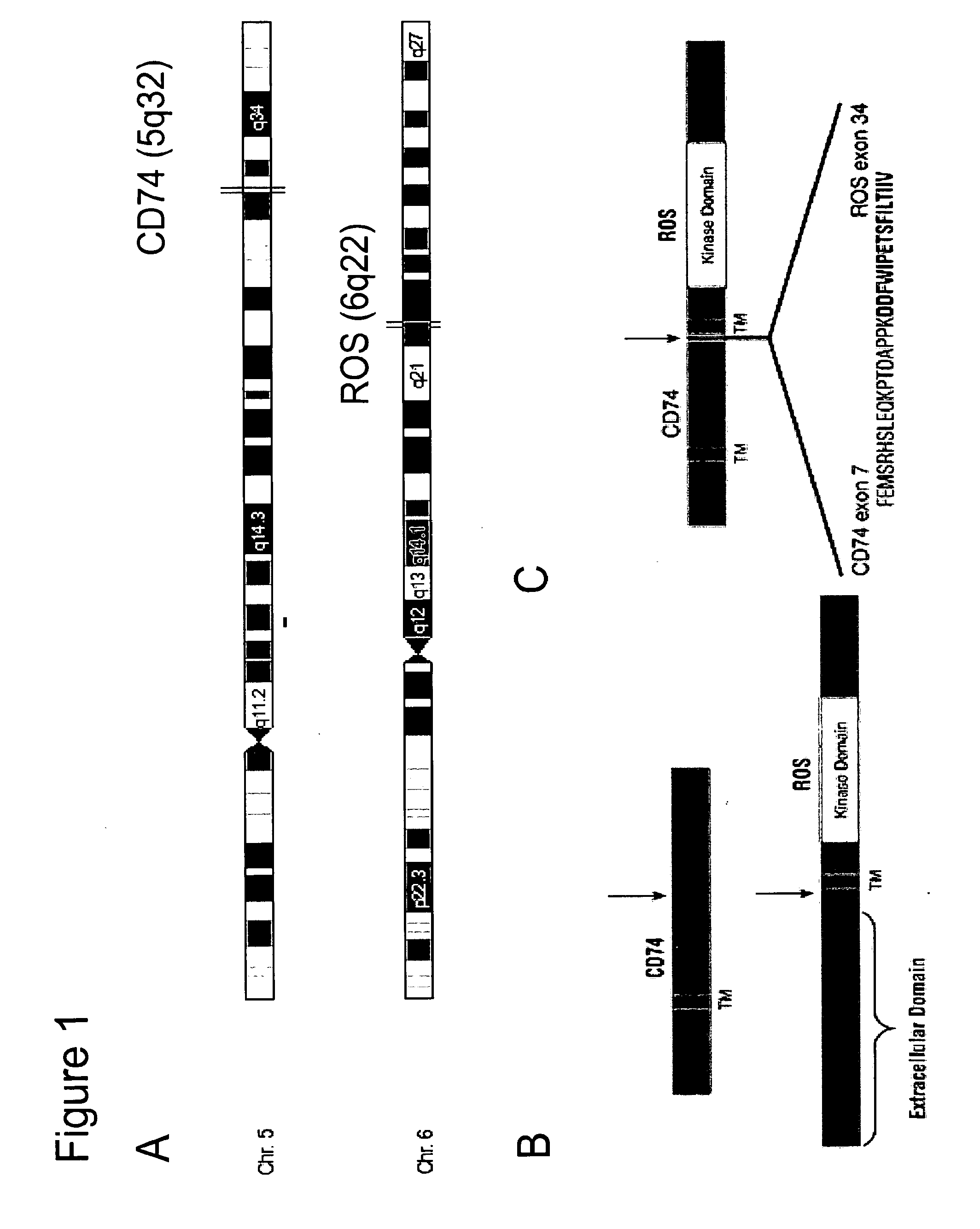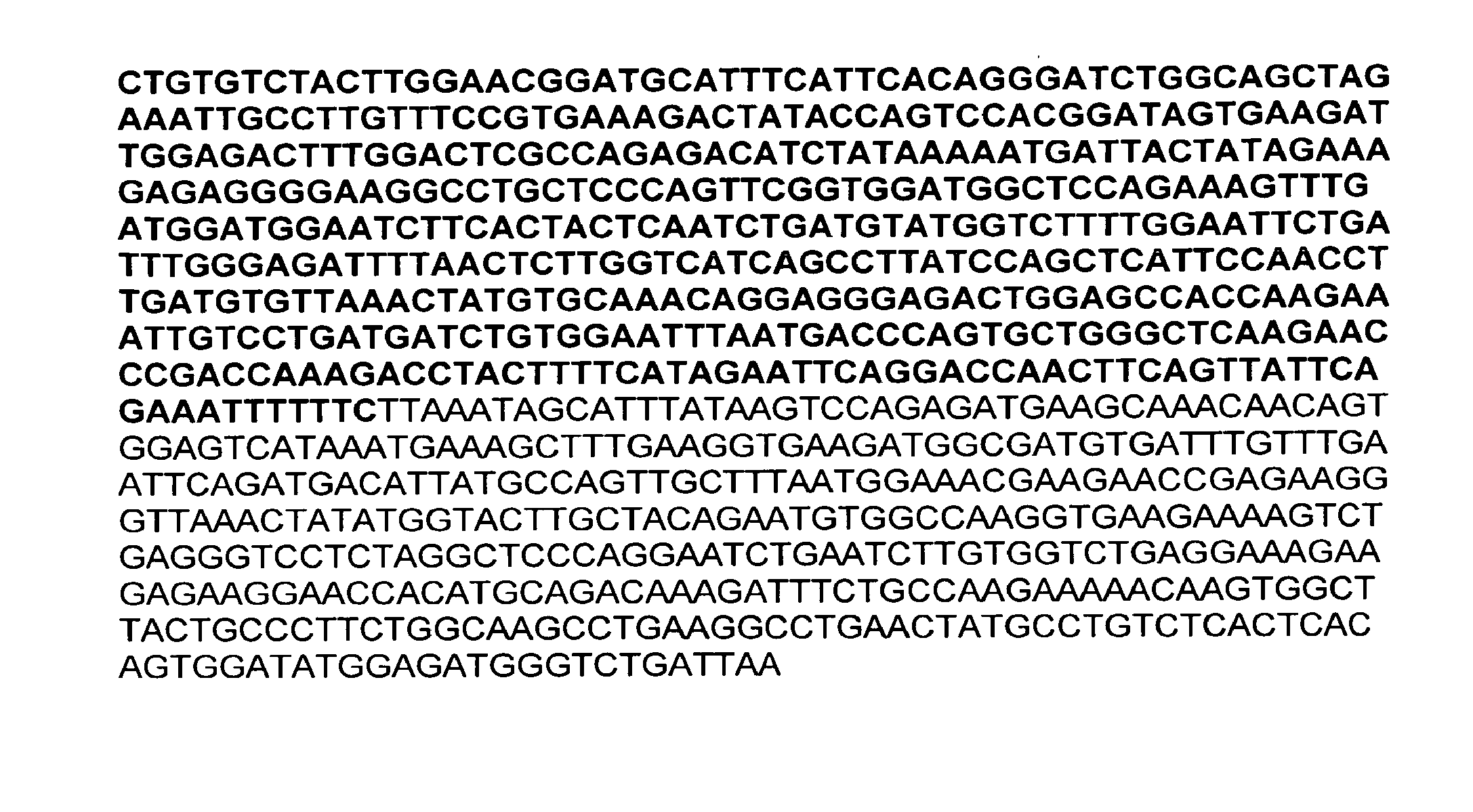Translocation and mutant ros kinase in human non-small cell lung carcinoma
a human non-small cell lung carcinoma and mutant technology, applied in the field of protein and gene involved in cancer, can solve the problems of unreported translocations in human nsclc cancer that involve protein kinases, uncontrolled growth and proliferation of cells, and inability to detect, diagnose and treat cancer, etc., to achieve the effect of preserving ros tyrosine kinase activity, driving the proliferation and survival of nsclc, and inhibiting the progression
- Summary
- Abstract
- Description
- Claims
- Application Information
AI Technical Summary
Benefits of technology
Problems solved by technology
Method used
Image
Examples
example 1
Identification of ROS Kinase Activity from NSCLC Patients by Global Phosphopeptide Profiling
[0246]The global phosphorylation profile of kinase activation in several human NSCLC patients, including CS042, were examined using a recently described and powerful technique for the isolation and mass spectrometric characterization of modified peptides from complex mixtures (the “IAP” technique, see
[0247]Rush et al., supra). The IAP technique was performed using a phosphotyrosine-specific antibody (CELL SIGNALING TECHNOLOGY, INC., Beverly, Mass., 2003 / 04 Cat. #9411) to isolate, and subsequently characterize, phosphotyrosine-containing peptides from extracts of the NSCLC cell lines.
[0248]Specifically, the IAP approach was employed go facilitate the identification of activated tyrosine kinases in the NSCLC patients, in order to identify novel drivers of this disease.
Phosphopeptide Immunoprecipitation
[0249]A total of 0.5 g tumor tissue was homogenized and lysed in urea lysis buffer (20 mM HEPE...
example 2
Isolation & Sequencing of CD74-ROS Fusion Gene
[0260]Given the presence of the activated form of ROS kinase detected in a NSCLC patient, 5′ rapid amplification of cDNA ends on the sequence encoding the kinase domain of ROS was conducted in order to determine whether a chimeric ROS transcript was present.
Rapid Amplification of Complementary DNA Ends
[0261]RNeasy Mini Kit (Qiagen) was used to extract RNA from CS045 cell line. DNA was extracted with the use of DNeasy Tissue Kit (Qiagen). Rapid amplification of cDNA ends was performed with the use of 5′ RACE system (Invitrogen) with primers ROS-GSP1 for cDNA synthesis and ROS-GSP2 and ROS-GSP3 for a nested PCR reaction.
[0262]For RT-PCR, first-strand cDNA was synthesized from 2.5 μg of total RNA with the use of SuperScript™ III first-strand synthesis system (Invitrogen) with oligo (dT)20. Then, the CD74-ROS fusion gene was amplified with the use of primer pairs CD74-F1 and ROS-GSP3:
(SEQ ID NO: 7)ROS-GSP1:ACCCTTCTCGGTTCTTCGTTTCCA(S...
example 3
Detection of CD74-ROS Fusion Protein Expression in a Human Cancer Sample Using FISH Assay
[0264]The presence of the CD74-ROS fusion protein in human NSCLC tumor samples was detected using a fluorescence in situ hybridization (FISH) assay, as previously described. See, e.g., Verma et al. HUMAN CHROMOSOMES: A MANUAL OF BASIC TECHNIQUES, Pergamon Press, New York, N.Y. (1988). Over 200 paraffin-embedded human NSCLC tumor samples were examined.
[0265]For analyzing rearrangements involving ROS, a dual color break-apart probe was designed. A proximal probe (BAC clone RP1-179P9) and two distal probes (BAC clone RP11-323O17, RP1-94G16) were labeled with Spectrum Orange dUTP or Spectrum Green dUTP, respectively. Labeling of the probes by nick translation and interphase FISH using FFPE tissue sections were done according to the manufactures instructions (Vysis) with the following modifications. In brief, paraffin embedded tissue sections were re-hydrated and subjected to microwave antigen retrie...
PUM
| Property | Measurement | Unit |
|---|---|---|
| Tm | aaaaa | aaaaa |
| Tm | aaaaa | aaaaa |
| Tm | aaaaa | aaaaa |
Abstract
Description
Claims
Application Information
 Login to View More
Login to View More - R&D
- Intellectual Property
- Life Sciences
- Materials
- Tech Scout
- Unparalleled Data Quality
- Higher Quality Content
- 60% Fewer Hallucinations
Browse by: Latest US Patents, China's latest patents, Technical Efficacy Thesaurus, Application Domain, Technology Topic, Popular Technical Reports.
© 2025 PatSnap. All rights reserved.Legal|Privacy policy|Modern Slavery Act Transparency Statement|Sitemap|About US| Contact US: help@patsnap.com



